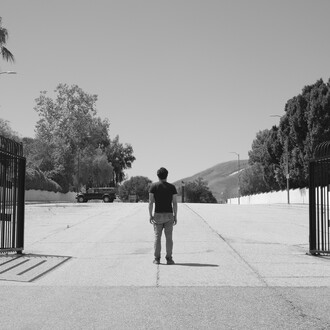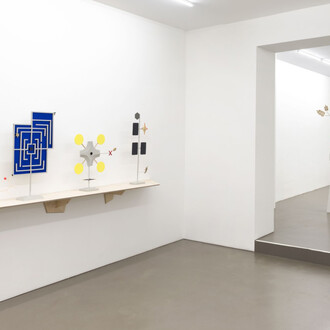Drawn from disused remnants of the airline industry, the sculptures of Michail Pirgelis both reinvigorate and challenge the conventions of post-minimalism, the readymade and conceptual art. Seven springs presents a new group of wall and floor sculptures that feature stripes and other flag-like elements. Together with wallpaper installations —a recent extension of the artist’s practice—they highlight Pirgelis’ relentless synthesis of sculpture, painting and environment.
At its core, Seven springs is an exploration of sculpture and the medium’s ability to carve out and affect space. Pirgelis’ latest works, in a palette of red, white, blue and silver, occupy a range of physical positions that explore the different spatial modes in which sculpture can function: freestanding on the floor, leaning against the wall, hanging on the wall. Most of the works exhibited here can be installed in various orientations depending on the spatial context, offering multiple perspectives, and emphasizing their sculptural quality. Through this considered placement, as well as the works’ recurring colors and visual motifs—stripes, color blocks, and the rivets and windows of the planes’ original surfaces—Pirgelis orchestrates a ricocheting movement from one work to another that pulls the viewer through the exhibition, making us consciously aware of the space we inhabit. In effect, the artist transforms the exhibition itself into a sculpture, defining sculpture as a means to define space.
Pirgelis pushes the boundary of sculpture by bringing in multilayered references to painting, art historical and sculptural ideas. The works in Seven springs follow the artist’s characteristic approach to material, comprising aluminum panels cut from decommissioned planes in so-called “aircraft boneyards.” The silver-toned panels of Pirgelis’ series A the giant (2024) carry fragments of lettering such as “A” or “m”. Their rows of rivets and industrial metallic surfaces recall minimalist sculpture in the tradition of Donald Judd; as does Southwest high (2025), where a row of oval airplane windows is tilted vertically, reminiscent of one of Judd's known “Stack” sculptures. At the same time, however, the minimalist approach is questioned. The surfaces of Pirgelis’ works are far from minimalism’s pristine finish—upon closer inspection, dents and scuffs make clear the weather and time that they have endured, imbuing them with a painterly, gestural character and a unique aura of history.
This painterly aspect is displayed in the stripes that appear on many of Pirgelis’ new works, bringing up a range of artistic and cultural references. In works such as Arizona apparel (2025) and Alaska (2025), fields of bold red-and-white stripes recall the work of Daniel Buren, who similarly experimented with expanding painting into multidimensional spaces and architecture. Together with the prominence of blue in several of Pirgelis’ sculptures, the stripes make an abstract reference to flags, particularly the American flag, subconsciously activating a shared social knowledge of symbols and sign systems. Titles of several sculptures also impart an oblique sense of Americana, including Aspen, Swing state, and Arizona apparel—the desert state where many of these plane parts originated. Pirgelis does not offer commentary on contemporary events through these citations; rather, he uses assonance and wordplay, and explores the geometric possibilities of color, line, form and surface.
Another key element to Pirgelis’ sculptural transformation of space in Seven Springs is his use of wallpapers. Eagle mountains (2025) appears in strategic sections of the gallery, carving it into distinct areas, generating optical effects, and thereby defining the viewer’s physical and visual experience within the exhibition. The replicating motif in Eagle mountains, with its crisscrossing eagle wings, reproduces a vintage American Airlines logo, linking Pirgelis' work to pop art and its use of graphical signs and logos.
Overall, Seven springs underlines Pirgelis' complex understanding of sculpture that not only pushes the medium within a multilayered reference system to new limits. Moreover, the exhibition’s dynamic spatial choreography mirrors the counterpoint of movement and stasis always inherent in Pirgelis’ sculptures. Movement through the subconscious perception of the original material as part of an airplane; and stasis due to the static nature of sculpture itself. The work Last resort (2024) offers a succinct crystallization of all these core ideas: a minimalist white monochrome—save for its empty rivet holes, red-striped edge, and numerous marks of use—bends upward from the wall at the work’s bottom-left side like a curling piece of paper. As it reaches away from the wall, it occupies at once the wall-space of “painting” and the room-space of “sculpture.”
















